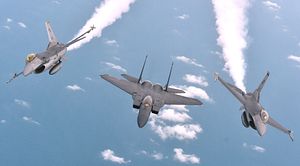This year, Singapore’s air force is commemorating its 50th anniversary. The occasion, along with the series of commemorative activities that have been planned for 2018, puts the focus not just on the city-state’s existing capabilities, but the ongoing transformation of the service in a changing threat environment.
The RSAF’s initial genesis was as the Singapore Air Defense Command (SADC) in 1968, before the RSAF itself was formally inaugurated in April 1, 1975 as the first assets were brought into service and the city-state began developing partnerships with other key countries (See: “US-Singapore Defense Ties in the Spotlight with Trump-Lee Visit”). This occurred at a time when Singapore had just achieved independence from Malaysia in 1965 and Britain had announced its decision to withdraw “East of Suez,” prompting a wave of anxiety across noncommunist Southeast Asian states in the midst of the Cold War.
Even as Singapore has since built up one of the most capable air forces in the region, it continues to seek to further develop its capabilities. Officially, since the mid-2000s, the objective has been to transform it to what is termed the 3rd Generation RSAF, part of a broader effort within the Singapore military to a fully networked and integrated high-tech service capable of handling a full spectrum of missions from peace to war. For the RSAF, that has involved a transformation across the board, including: revamping its organizational structure, procuring advanced platforms and capabilities; developing new, integrated concepts and approaches; and equipping better personnel with the necessary skills and knowledge to support this change.
In 2018, Singapore is commemorating the 50th anniversary of the RSAF. Much like the 50th anniversary of the Republic of Singapore Navy (RSN) last year, the city-state has planned a series of commemorative events tied to this (See: “Singapore Launches First New Warship Amid Navy Anniversary”). The logo for RSN50, which has already been unveiled, is a numerical “50” flown by the F-15SG, with a tagline of “Our Home, Above All” indicating its continued commitment to defending Singapore.
There are also expected to be a range of events held through the rest of the year in conjunction with RSN50, including an airshow, a parade, exhibits, flypasts, and other commemorative activities in different parts of the city-state. The first key commemorative event will be the 2018 Singapore Airshow. Expected to be held from February 6 to 11, it will feature a record number of RSAF assets on static display as well as the first-ever integrated aerial display involving an F-15SG and two F-16s, which will be for public viewing.
That will be followed by RSAF50 celebrations at several locations throughout the city-state. From March to May, these will take place at five designated “Heartland locations” – Toa Payoh, Sembawang, Punggol, Bedok, and Jurong East – each of which will feature unique exhibits and demonstrations, including live helicopter operations in Sembawang for the first time. There will also be one held at Marina Barrage during the National Day weekend in August, the highlight of which will be a commemorative RSAF50 aerial flypast with more than 20 RSAF assets and aerial displays by the F-15SG, F-16C/Ds multi-role fighter aircraft and AH-64Ds Apache helicopters.
The last major commemorative activity will be the RSAF50 Parade on September 1, in conjunction with the actual date of the RSAF’s anniversary itself. The parade, which will be presided over by Prime Minister Lee Hsien Loong as the guest of honor, will have several activities including a parade march-past and a flypast, with several highlights including the first public appearance of the multi-role tanker transport (MRTT) aircraft.
A range of other ongoing interactions will occur as well throughout the year either as part of these major commemorative activities or apart from them, including contributions of Singapore officials to the RSAF50 Mural, education efforts, and key addresses on the state of the RSAF and Singapore’s defense more generally in the region and the world.































